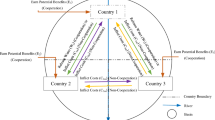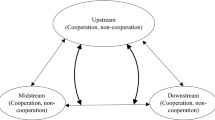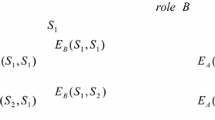Abstract
Accurately simulating the dynamic evolution of the behaviors of different decision-makers (DMs) is essential for identifying solutions to transboundary water conflicts. The purpose of this study is to present a dynamic evolutionary analysis model for simulating the behavior of different water users and solving the problem of transboundary water conflicts. To accomplish this goal, a revenue function, which can objectively evaluate the relative preferences of different DMs in water conflicts, was constructed to improve the graph model for conflict resolution (GMCR) model. A demonstration area in the Yangtze River Delta on ecologically friendly development (DAYRD) in China is applied to demonstrate the applicability of the improved method. The results show that the improved GMCR model based on the revenue function can accurately simulate the dynamic evolution of transboundary water conflicts and avoid the influence of subjective factors of researchers or experts in the traditional method. Additionally, the results indicated that water conflicts in the DAYRD can be transformed from the status quo (conflict) to the target state (cooperation) by effectively controlling the intensity of third-party intervention. These findings provide useful insights for the resolution of transboundary water conflicts and enhance our understanding of the role of third parties in transforming conflict into cooperation.






Similar content being viewed by others
Data Availability
The data is available upon request.
References
Acemoglu D, Wolitzky A (2014) Cycles of Conflict: An Economic Model. Am Eco Rev 104:1350–1367. https://doi.org/10.1257/aer.104.4.1350
Ali S, Xu H, Al-amin AQ, Ahmad N (2019) Energy sources choice and environmental sustainability disputes: an evolutional graph model approach. Quality Quantity 53:561–581. https://doi.org/10.1007/s11135-018-0775-9
Chen YZ, Lu HW, Li J, Ren LX, He L (2017) A leader-follower-interactive method for regional water resources management with considering multiple water demands and eco-environmental constraints. J Hydrol 548:121–134. https://doi.org/10.1016/j.jhydrol.2017.02.015
Chu Y, Hipel KW, Fang LP, Wang HM (2015) Systems methodology for resolving water conflicts: the Zhanghe River water allocation dispute in China. Intern J Water Resour Develop 31:106–119. https://doi.org/10.1080/07900627.2014.933096
Degefu DM, He WJ, Yuan L, Zhao JH (2016) Water Allocation in Transboundary River Basins under Water Scarcity: a Cooperative Bargaining Approach. Water Resour Manag 30:4451–4466. https://doi.org/10.1007/s11269-016-1431-6
Di D, Wu Z, Wang H, Lv C (2020) A Double-Layer Dynamic Differential Game Model for the Optimal Trading Quantity of Water and Price Setting in Water Rights Transactions. Water Resour Manag 34:245–262. https://doi.org/10.1007/s11269-019-02437-y
Dong Q, Zhang X, Chen Y, Fang D (2019) Dynamic Management of a Water Resources-Socioeconomic-Environmental System Based on Feedbacks Using System Dynamics. Water Resour Manag 33:2093–2108. https://doi.org/10.1007/s11269-019-02233-8
Dowlatabadi N, Banihabib ME, Roozbahani A, Randhir TO (2020) Enhanced GMCR model for resolving conflicts in a transboundary wetland. Sci Total Environ 744:140816. https://doi.org/10.1016/j.scitotenv.2020.140816
Du JL, Liu Y, Forrest JYL (2019) An interactive group decision model for selecting treatment schemes for mitigating air pollution. Environ Sci Pollut Res 26:18687–18707. https://doi.org/10.1007/s11356-019-05072-7
Fang LP, Hipel KW, Kilgour DM, Peng XY (2003a) A decision support system for interactive decision making - part I: Model formulation. IEEE Transactions on Systems, Man, and Cybernetics. Part C (applications and Reviews) 33:42–55. https://doi.org/10.1109/Tsmcc.2003.809361
Fang LP, Hipel KW, Kilgour DM, Peng XY (2003b) A decision support system for interactive decision making - Part II: analysis and output interpretation. IEEE Transactions on Systems, Man, and Cybernetics. Part C (applications and Reviews) 33:56–66. https://doi.org/10.1109/TSMCC.2003.809360
Garcia A, Hipel KW (2017) Inverse engineering preferences in simple games. Appl Math Comput 311:184–194. https://doi.org/10.1016/j.amc.2017.05.016
Garrick DE, De Stefano L (2016) Adaptive capacity in federal rivers: coordination challenges and institutional responses. Current Opinion Environ Sustain 21:78–85. https://doi.org/10.1016/j.cosust.2016.11.003
Geressu RT, Harou JJ (2015) Screening reservoir systems by considering the efficient trade-offs—informing infrastructure investment decisions on the Blue Nile. Environ Res Let 10:125008. https://doi.org/10.1088/1748-9326/10/12/125008
Han QY, Zhu YM, Ke GY, Lin HL (2019) A Two-Stage Decision Framework for Resolving Brownfield Conflicts. Intern J Environ Res Pub Health 16:1039. https://doi.org/10.3390/ijerph16061039
He SW, Hipel KW, Xu HY, Chen Y (2020) A Two-Level Hierarchical Graph Model for Conflict Resolution with Application to International Climate Change Negotiations. J Syst Sci Syst Eng 29:251–272. https://doi.org/10.1007/s11518-019-5448-2
Hipel K, Kilgour DM, Kinsara RA (2014) Strategic Investigations of Water Conflicts in the Middle East. Group Decision and Negotiation 23:355–376. https://doi.org/10.1007/s10726-012-9325-3
Ke GY, Li KW, Hipel KW (2012) An integrated multiple criteria preference ranking approach to the Canadian west coast port congestion conflict. Expert Syst App 39:9181–9190. https://doi.org/10.1016/j.eswa.2012.02.086
Kilgour DM, Hipel KW (2005) The graph model for conflict resolution: Past, present, and future. Group Decision and Negotiation 14:441–460. https://doi.org/10.1007/s10726-005-9002-x
Kilgour DM, Hipel KW, Fang L (1987) The graph model for conflicts. Automatica, 23: 41–55. https://doi.org/10.1016/0005-1098(87)90117-8
Kinsara RA, Kilgour DM, Hipel KW (2012) Conflict resolution and mediation. IEEE International Conference on Systems, Man, and Cybernetics (SMC), 2780–2784. https://doi.org/10.1109/ICSMC.2012.6378169
Langenegger TW, Hipel KW (2019) The Strategy of Escalation and Negotiation: The Iran Nuclear Dispute. J Syst Sci Syst Eng 28:434–448. https://doi.org/10.1007/s11518-019-5421-0
Lankford B (2013) Does Article 6 (Factors Relevant to Equitable and Reasonable Utilization) in the UN Watercourses Convention misdirect riparian countries? Water Intern 38:130–145. https://doi.org/10.1080/02508060.2013.780687
Li KW, Levy JK, Buckley P (2009) Enhancing National Security and Energy Security in the Post-911 Era: Group Decision Support for Strategic Policy Analysis under Conditions of Conflict. Group Decis Negot 18:369–386. https://doi.org/10.1007/s10726-008-9147-5
Liu Y, Mao D (2020) Integrated assessment of water quality characteristics and ecological compensation in the Xiangjiang River, south-central China. Ecol Indic 110: 105922. https://doi.org/10.1016/j.ecolind.2019.105922
Lu YL, Jenkins A, Ferrier RC, Bailey M, Gordon IJ, Song S et al (2015) Addressing China’s grand challenge of achieving food security while ensuring environmental sustainability. Sci Adv 1:e1400039. https://doi.org/10.1126/sciadv.1400039
Madani K, Sheikhmohammady M, Mokhtari S, Moradi M, Xanthopoulos P (2014) Social Planner’s Solution for the Caspian Sea Conflict. Group Decis Negot 23:579–596. https://doi.org/10.1007/s10726-013-9345-7
Nandalal KDW, Simonovic SP (2003) Resolving conflicts in water sharing: A systemic approach. Water Resour Res 39. https://doi.org/10.1029/2003WR002172
Nazari S, Ahmadi A, Kamrani Rad S, Ebrahimi B (2020) Application of non-cooperative dynamic game theory for groundwater conflict resolution. J Environ Manag 270: 110889. https://doi.org/10.1016/j.jenvman.2020.110889
Petersen-Perlman JD, Veilleux JC, Wolf AT (2017) International water conflict and cooperation: challenges and opportunities. Water Intern 42:105–120. https://doi.org/10.1080/02508060.2017.1276041
Philpot S, Hipel K, Johnson P (2016) Strategic analysis of a water rights conflict in the south western United States. J Environ Manag 180:247–256. https://doi.org/10.1016/j.jenvman.2016.05.027
Shi GM, Wang JN, Zhang B, Zhang Z, Zhang YL (2016) Pollution control costs of a transboundary river basin: Empirical tests of the fairness and stability of cost allocation mechanisms using game theory. J Environ Manag 177:145–152. https://doi.org/10.1016/j.jenvman.2016.04.015
Sun J, Dang Z, Zheng S (2017) Development of payment standards for ecosystem services in the largest interbasin water transfer projects in the world. Agric Water Manag 182: 158–164. https://doi.org/10.1016/j.agwat.2016.06.025
Taravatrooy N, Nikoo MR, Adamowski JF, Khoramshokooh N (2019) Fuzzy-based conflict resolution management of groundwater in-situ bioremediation under hydrogeological uncertainty. J Hydrol 571:376–389. https://doi.org/10.1016/j.jhydrol.2019.01.063
Tarebari H, Javid AH, Mirbagheri SA, Fahmi H (2018) Multi-Objective Surface Water Resource Management Considering Conflict Resolution and Utility Function Optimization. Water Resour Manag 32:4487–4509. https://doi.org/10.1007/s11269-018-2051-0
Tayia A (2019) Transboundary Water Conflict Resolution Mechanisms: Substitutes or Complements. Water 11:1337 https://doi.org/10.3390/w11071337
UN Water (2013) Transboundary waters. https://www.unwater.org/water-facts/transboundary-waters. Accessed 1 Jun 2021
Veldkamp TIE, Wada Y, Aerts JCJH, Doll P, Gosling SN, Liu J et al (2017) Water scarcity hotspots travel downstream due to human interventions in the 20th and 21st century. Nat Commun 8:15697. https://doi.org/10.1038/ncomms15697
Walker SB, Hipel KW (2017) Strategy, Complexity and Cooperation: The Sino-American Climate Regime. Group Decis Negot 26:997–1027. https://doi.org/10.1007/s10726-017-9528-8
Wang H, Zhang J, Zeng W (2018) Intelligent simulation of aquatic environment economic policy coupled ABM and SD models. Sci Total Environ 618: 1160–1172. https://doi.org/10.1016/j.scitotenv.2017.09.184
Wei S, Yang H, Abbaspour K, Mousavi J, Gnauck A (2010) Game theory based models to analyze water conflicts in the Middle Route of the South-to-North Water Transfer Project in China. Water Res 44:2499–2516. https://doi.org/10.1016/j.watres.2010.01.021
Xu L, Zhang Q, Shi XP (2019) Stakeholders strategies in poverty alleviation and clean energy access: A case study of China’s PV poverty alleviation program. Energy Policy 135:111011. https://doi.org/10.1016/j.enpol.2019.111011
Yao H, Qian X, Yin H, Gao H, Wang Y (2015) Regional Risk Assessment for Point Source Pollution Based on a Water Quality Model of the Taipu River, China. Risk Analysis 35: 265–277. https://doi.org/10.1111/risa.12259
Yin KD, Yu L, Li XM (2017) An Improved Graph Model for Conflict Resolution Based on Option Prioritization and Its Application. Intern J Environ Res Pub Health 14:1311. https://doi.org/10.3390/ijerph14111311
Yu J, Hipel KW, Kilgour DM, Fang LP (2019a) Fuzzy levels of preference strength in a graph model with multiple decision makers. Fuzzy Sets Syst 377:71–84. https://doi.org/10.1016/j.fss.2018.12.016
Yu J, Kilgour DM, Hipel KW, Zhao M (2015) Power asymmetry in conflict resolution with application to a water pollution dispute in China. Water Resour Res 51:8627–8645. https://doi.org/10.1002/2014wr016257
Yu Y, Tang PZ, Zhao JS, Liu B, Mclaughlin D (2019) Evolutionary Cooperation in Transboundary River Basins. Water Resour Res 55:9977–9994. https://doi.org/10.1029/2019wr025608
Yuan L, He WJ, Degefu DM, Liao ZY, Wu X, An M et al (2020) Transboundary water sharing problem; a theoretical analysis using evolutionary game and system dynamics. J Hydrol 582:124521. https://doi.org/10.1016/j.jhydrol.2019.124521
Zanjanian H, Abdolabadi H, Niksokhan MH, Sarang A (2018) Influential third party on water right conflict: A Game Theory approach to achieve the desired equilibrium (case study: Ilam dam, Iran). J Envirn Manag 214:283–294. https://doi.org/10.1016/j.jenvman.2018.03.023
Zhang H, Liu S, Ye J, Yeh PJF (2017) Model simulations of potential contribution of the proposed Huangpu Gate to flood control in the Lake Taihu basin of China. Hydrol Earth Syst Sci 21:5339–5355. https://doi.org/10.5194/hess-21-5339-2017
Zhao SN, Xu HY (2019) A Novel Preference Elicitation Technique Based on a Graph Model and Its Application to a Brownfield Redevelopment Conflict in China. Intern J Environ Res Pub Health 16:4088. https://doi.org/10.3390/ijerph16214088
Zomorodian M, Lai SH, Homayounfar M, Ibrahim S, Pender G (2017) Development and application of coupled system dynamics and game theory: A dynamic water conflict resolution method. PLoS One 12:e0188489. https://doi.org/10.1371/journal.pone.0188489
Acknowledgements
This study was supported by the Major Science and Technology Program for Water Pollution Control and Treatment of China [grant number 2017ZX07207003-01]. We also thank the Taihu Basin Authority for providing relevant information and data.
Funding
This research was supported by the Major Science and Technology Program for Water Pollution Control and Treatment [grant number 2017ZX07207003-01].
Author information
Authors and Affiliations
Contributions
M.J. Yang: Conceptualization, Formal analysis, Investigation, Methodology, Writing—original draft. K. Yang: Conceptualization, Funding acquisition, Writing—reviewing and editing. Y. Che: Conceptualization, Writing—reviewing and editing. S.Q. Lu: Validation, Resources. F.Y. Sun: Validation, Writing—reviewing and editing. Y. Chen: Formal analysis, Investigation. M.T. Li: Formal analysis, Investigation.
Corresponding authors
Ethics declarations
Consent to Publish
All authors agree for publication of this manuscript in WARM.
Competing Interests
None.
Additional information
Publisher's Note
Springer Nature remains neutral with regard to jurisdictional claims in published maps and institutional affiliations.
Supplementary Information
Below is the link to the electronic supplementary material.
Rights and permissions
About this article
Cite this article
Yang, M., Yang, K., Che, Y. et al. Resolving Transboundary Water Conflicts: Dynamic Evolutionary Analysis Using an Improved GMCR Model. Water Resour Manage 35, 3321–3338 (2021). https://doi.org/10.1007/s11269-021-02895-3
Received:
Accepted:
Published:
Issue Date:
DOI: https://doi.org/10.1007/s11269-021-02895-3




